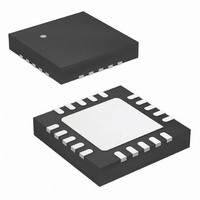ATTINY44-15MZ Atmel, ATTINY44-15MZ Datasheet - Page 129

ATTINY44-15MZ
Manufacturer Part Number
ATTINY44-15MZ
Description
MCU AVR 4K FLASH 15MHZ 20-QFN
Manufacturer
Atmel
Series
AVR® ATtinyr
Datasheet
1.ATTINY44-15MZ.pdf
(225 pages)
Specifications of ATTINY44-15MZ
Package / Case
20-QFN Exposed Pad
Voltage - Supply (vcc/vdd)
2.7 V ~ 5.5 V
Operating Temperature
-40°C ~ 125°C
Speed
16MHz
Number Of I /o
12
Eeprom Size
256 x 8
Core Processor
AVR
Program Memory Type
FLASH
Ram Size
256 x 8
Program Memory Size
4KB (4K x 8)
Data Converters
A/D 8x10b
Oscillator Type
Internal
Peripherals
Brown-out Detect/Reset, POR, PWM, WDT
Connectivity
USI
Core Size
8-Bit
Processor Series
ATTINY4x
Core
AVR8
Data Bus Width
8 bit
Data Ram Size
256 B
Interface Type
SPI, UART
Maximum Clock Frequency
16 MHz
Number Of Programmable I/os
12
Number Of Timers
2
Maximum Operating Temperature
+ 85 C
Mounting Style
SMD/SMT
3rd Party Development Tools
EWAVR, EWAVR-BL
Development Tools By Supplier
ATAVRDRAGON, ATSTK500, ATSTK600, ATAVRISP2, ATAVRONEKIT
Minimum Operating Temperature
- 40 C
On-chip Adc
10 bit, 8 Channel
Lead Free Status / RoHS Status
Lead free / RoHS Compliant
Available stocks
Company
Part Number
Manufacturer
Quantity
Price
Company:
Part Number:
ATTINY44-15MZ
Manufacturer:
ATMEL
Quantity:
1 000
Part Number:
ATTINY44-15MZ
Manufacturer:
ATMEL/爱特梅尔
Quantity:
20 000
- Current page: 129 of 225
- Download datasheet (4Mb)
16.3.5
16.3.6
16.4
16.4.1
16.4.2
16.4.3
16.4.4
16.4.5
7701E–AVR–02/11
Alternative USI Usage
Start Condition Detector
Clock speed considerations
Half-duplex Asynchronous Data Transfer
4-bit Counter
12-bit Timer/Counter
Edge-Triggered External Interrupt
Software Interrupt
The start condition detector is shown in
the range of 50 to 300ns) to ensure valid sampling of the SCL line. The start condition detector
is only enabled in two-wire mode.
The start condition detector is working asynchronously, and can, therefore, wake up the pro-
cessor from the power-down sleep mode. However, the protocol used might have restrictions
on the SCL hold time. Therefore, when using this feature in this case, the oscillator start-up
time set by the CKSEL fuses (see
also be taken into consideration. See the USISIF bit description in
ister” on page 130
Maximum frequency for SCL and SCK is f
receive rate in both two- and three-wire mode. In two-wire slave mode the two-wire clock con-
trol unit will hold SCL low until the slave is ready to receive more data. This may reduce the
actual data rate in two-wire mode.
When the USI unit is not used for serial communication, it can be set up to do alternative tasks
due to its flexible design.
By utilizing the Shift Register in Three-wire mode, it is possible to implement a more compact
and higher performance UART than by software only.
The 4-bit counter can be used as a stand-alone counter with overflow interrupt. Note that if the
counter is clocked externally, both clock edges will generate an increment.
Combining the USI 4-bit counter and Timer/Counter0 allows them to be used as a 12-bit
counter.
By setting the counter to maximum value (F), it can function as an additional external interrupt.
The overflow flag and interrupt enable bit are then used for the external interrupt. This feature
is selected by the USICS1 bit.
The counter overflow interrupt can be used as a software interrupt triggered by a clock strobe.
for further details.
Atmel ATtiny24/44/84 [Preliminary]
“Clock Systems and their Distribution” on page
Figure 16-6 on page
CK
/4. This is also the maximum data transmit and
128. The SDA line is delayed (in
“USISR – USI Status Reg-
25) must
129
Related parts for ATTINY44-15MZ
Image
Part Number
Description
Manufacturer
Datasheet
Request
R

Part Number:
Description:
Manufacturer:
Atmel Corporation
Datasheet:

Part Number:
Description:
Manufacturer:
Atmel Corporation
Datasheet:

Part Number:
Description:
IC MCU AVR 4K FLASH 20MHZ 20-QFN
Manufacturer:
Atmel
Datasheet:

Part Number:
Description:
IC MCU AVR 4K FLASH 20MHZ 14SOIC
Manufacturer:
Atmel
Datasheet:

Part Number:
Description:
MCU AVR 4KB FLASH 20MHZ 14SOIC
Manufacturer:
Atmel
Datasheet:

Part Number:
Description:
MCU AVR 4KB FLASH 20MHZ 20QFN
Manufacturer:
Atmel
Datasheet:

Part Number:
Description:
IC MCU AVR 4K FLASH 15MHZ 14SOIC
Manufacturer:
Atmel
Datasheet:

Part Number:
Description:
IC MCU AVR 4K FLASH 20MHZ 14-DIP
Manufacturer:
Atmel
Datasheet:

Part Number:
Description:
Manufacturer:
Atmel Corporation
Datasheet:

Part Number:
Description:
Microcontrollers (MCU) 512B FL 32B SRAM TIMER ATTINY4 12MHz
Manufacturer:
Atmel

Part Number:
Description:
IC MCU AVR 512B FLASH SOT-23-6
Manufacturer:
Atmel
Datasheet:

Part Number:
Description:
IC MCU AVR 512B FLASH SOT-23-6
Manufacturer:
Atmel
Datasheet:












